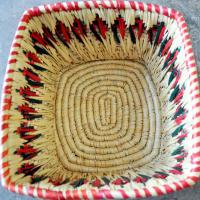Design Gallery
Moonj Basketry Making
The Process of Making products of Moonj-wild grass
by
The village Naini in Allahabad is the major producer of Moonj-wild grass products. Moonj and Kaasa are the types of wild grass that richly grows near the banks of the river in and around vast areas of Allahabad. Allahabad, Gorakhpur and Behraich in Uttar Pradesh are the major centers for moonj crafts. Manufacturing process involves simple technique which is skillfully done by using natural grass and basic local made tools. Dyeing is done to color the grass. Kaccha rang -raw colors are used to dye the grass. Water is boiled at high temperature in aluminum container and the color powder is added to it. The dried off-white Moonj grass is immersed in the boiling solution to absorb the color. The grass is removed once it attains color and allowed to dry under shade. The dyed grass is mainly used to create and highlight the motif patterns. Red and green are the two main dominating colors used in basket weaving. The making process is time consuming and basically done by the women at their free time. The traditional coiling technique is used to create the traditional and contemporary products. Dried Moonj grass is made into small knots which are called 'Balla' locally. This Balla is soaked in cold water for some time before coiling to ensure flexibility. The grass Kaasa is used as inside stuffing, wherein Moonj is used to wrap around Kaasa grass to make coil. The formed coil is winded in a series to make the base of basket. Once the base is formed, the walls of the basket are made using the same technique. These coils are stitched together to make the basket strong. The handles of the basket are made and attached by stitching with the grass. More details at: Moonj Basketry Making.
For more details:
http://dsource.in/resource/moonj-basketry-allahabad























